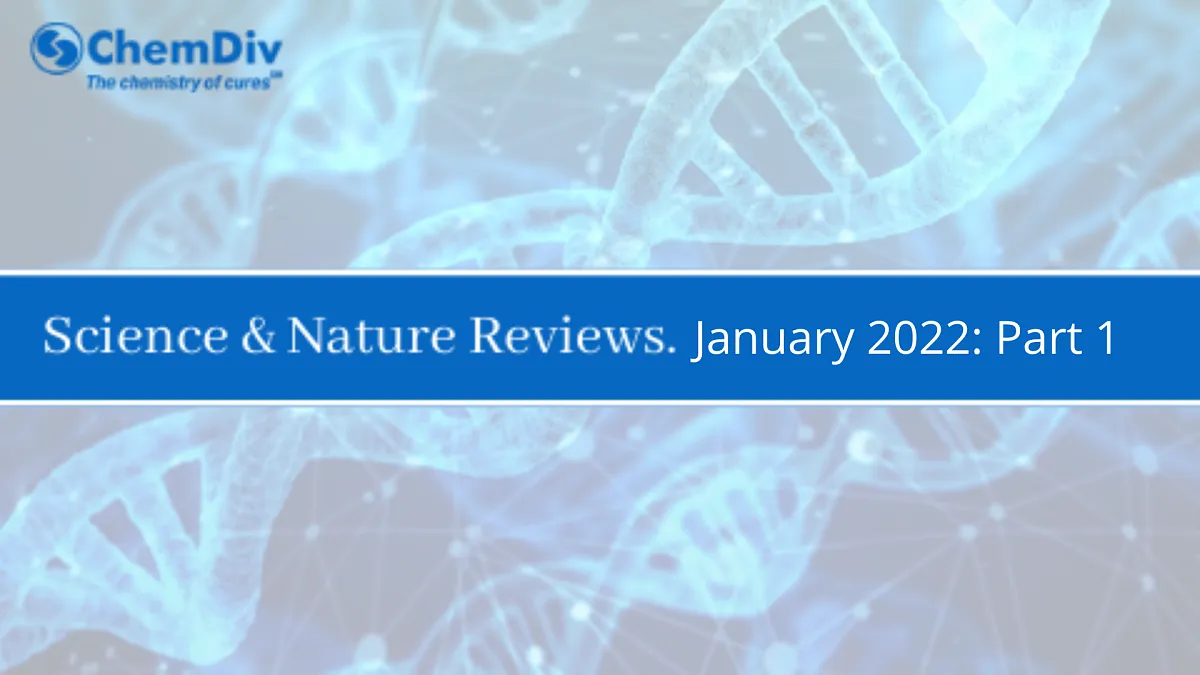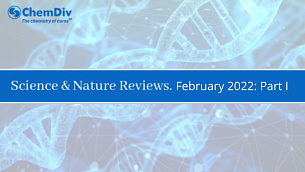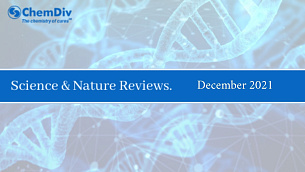Science & Nature Reviews, January 2021. Part I

ChemDiv shares reviews on Nature and Science Journal articles that we found the most exciting this month. Today we observe COVID-19, Molecular biology, Physiology, Neurophysiology, and Embryology.
COVID-19
Goel, R. R., Painter, M. M., Apostolidis, S. A. et al. mRNA vaccines induce durable immune memory to SARS-CoV-2 and variants of concern. Science 374, 6572 (2021)
The COVID‑19 pandemic and the development of various vaccine platforms remain one of the most pressing global public health issues. At least nine different technology platforms are being used to create an effective vaccine, including nucleoside-modified messenger RNA and DNA, viral vectors, peptides, recombinant proteins, live attenuated viruses, and inactivated viruses. Several COVID-19 vaccines have been developed to use nucleoside-modified messenger RNA to stimulate an immune response. These vaccines were the first authorized vaccines in many countries due to their high effectiveness at preventing severe COVID-19. However, the evolution of viral variants and increasing infections in vaccinated individuals have raised questions about the durability of immunity after vaccination. Scientists analyzed the T- and B-immune cell responses in individuals who received messenger RNA vaccines. They found out that humoral and cellular immune memory in vaccinated individuals may limit the development of severe disease.
Molecular biology
Spinelli, J.B., Rosen, P. C., Sprenger, H. et al. Fumarate is a terminal electron acceptor in the mammalian electron transport chain. Science 374, 6572 (2021)
Mitochondria is a special cell organelle that generates most of the cell's supply of chemical energy, using oxygen in a special mechanism called an electron transport chain. The electron transport chain consists of protein complexes, which carry out oxidation-reduction reactions. Typically, electrons flow through the electron transport chain, ending up with oxygen as the terminal electron acceptor. This process is important for energy production and biosynthesis. On pages of «Science» researchers characterized an alternative electron acceptor called fumarate. This path of electrons is necessary for cells to exist in oxygen-poor environments. Studying this mechanism can be useful in medicine and biotechnology.
Physiology
Gulluni, F., Prever, L., Li, H. et al. PI(3,4)P2-mediated cytokinetic abscission prevents early senescence and cataract formation. Science 374, 6573 (2021)
Senescence plays a major role in the onset of various degenerative diseases, including the slow development of cataracts, a clouding of the eye lens that troubles the vision of millions of people worldwide. The reason is the processes that take place during the division of the lens cells. On pages of «Science» scientists report that mutations or loss of gene PIK3C2A inhibit cytokinesis (the part of the cell division process) and triggers lens cell senescence and cataract formation. These results may be useful for the development of new methods of cataract therapy.
Neurophysiology
Grigg, J.B., Shanmugavadivu, A., Regen, T. et al. Antigen-presenting innate lymphoid cells orchestrate neuroinflammation. Nature 600, 707–712 (2021)
Multiple sclerosis is a demyelinating disease, in which the insulating covers of nerve cells in the brain and spinal cord are damaged. The damage disrupts the ability of parts of the nervous system to transmit signals, resulting in physical, mental, and psychiatric problems. In the new issue of «Nature,» scientists define a population of inflammatory group lymphoid cells (ILC3s). These ILC3s localize in proximity to the central nervous system and contribute to the development of the disease. By contrast, conventional and tissue-resident ILC3s in the periphery prevent multiple sclerosis-like diseases. These data reveal the potential of harnessing peripheral tissue-resident ILC3s for the prevention of autoimmune disease.
Embryology
Kagawa, H., Javali, A., Khoei, H.H. et al. Human blastoids model blastocyst development and implantation. Nature (2021)
Human embryogenesis is the development and formation of the human embryo. During the germinal stage, the zygote begins to divide. A blastocyst is then formed and implanted in the uterus. Embryogenesis continues with the next stage when the three germ layers of the embryo form and the processes of neurulation and organogenesis follow. The study of human embryogenesis is not an easy task due to the ethical side of the issue. Scientists solved the problem by developing a blastoid, a blastocyst model composed of stem cells. These cells form analogs of three germ layers of the blastocyst stage.
Reviewed by Maria Golubenko
COVID-19
Goel, R. R., Painter, M. M., Apostolidis, S. A. et al. mRNA vaccines induce durable immune memory to SARS-CoV-2 and variants of concern. Science 374, 6572 (2021)
The COVID‑19 pandemic and the development of various vaccine platforms remain one of the most pressing global public health issues. At least nine different technology platforms are being used to create an effective vaccine, including nucleoside-modified messenger RNA and DNA, viral vectors, peptides, recombinant proteins, live attenuated viruses, and inactivated viruses. Several COVID-19 vaccines have been developed to use nucleoside-modified messenger RNA to stimulate an immune response. These vaccines were the first authorized vaccines in many countries due to their high effectiveness at preventing severe COVID-19. However, the evolution of viral variants and increasing infections in vaccinated individuals have raised questions about the durability of immunity after vaccination. Scientists analyzed the T- and B-immune cell responses in individuals who received messenger RNA vaccines. They found out that humoral and cellular immune memory in vaccinated individuals may limit the development of severe disease.
Molecular biology
Spinelli, J.B., Rosen, P. C., Sprenger, H. et al. Fumarate is a terminal electron acceptor in the mammalian electron transport chain. Science 374, 6572 (2021)
Mitochondria is a special cell organelle that generates most of the cell's supply of chemical energy, using oxygen in a special mechanism called an electron transport chain. The electron transport chain consists of protein complexes, which carry out oxidation-reduction reactions. Typically, electrons flow through the electron transport chain, ending up with oxygen as the terminal electron acceptor. This process is important for energy production and biosynthesis. On pages of «Science» researchers characterized an alternative electron acceptor called fumarate. This path of electrons is necessary for cells to exist in oxygen-poor environments. Studying this mechanism can be useful in medicine and biotechnology.
Physiology
Gulluni, F., Prever, L., Li, H. et al. PI(3,4)P2-mediated cytokinetic abscission prevents early senescence and cataract formation. Science 374, 6573 (2021)
Senescence plays a major role in the onset of various degenerative diseases, including the slow development of cataracts, a clouding of the eye lens that troubles the vision of millions of people worldwide. The reason is the processes that take place during the division of the lens cells. On pages of «Science» scientists report that mutations or loss of gene PIK3C2A inhibit cytokinesis (the part of the cell division process) and triggers lens cell senescence and cataract formation. These results may be useful for the development of new methods of cataract therapy.
Neurophysiology
Grigg, J.B., Shanmugavadivu, A., Regen, T. et al. Antigen-presenting innate lymphoid cells orchestrate neuroinflammation. Nature 600, 707–712 (2021)
Multiple sclerosis is a demyelinating disease, in which the insulating covers of nerve cells in the brain and spinal cord are damaged. The damage disrupts the ability of parts of the nervous system to transmit signals, resulting in physical, mental, and psychiatric problems. In the new issue of «Nature,» scientists define a population of inflammatory group lymphoid cells (ILC3s). These ILC3s localize in proximity to the central nervous system and contribute to the development of the disease. By contrast, conventional and tissue-resident ILC3s in the periphery prevent multiple sclerosis-like diseases. These data reveal the potential of harnessing peripheral tissue-resident ILC3s for the prevention of autoimmune disease.
Embryology
Kagawa, H., Javali, A., Khoei, H.H. et al. Human blastoids model blastocyst development and implantation. Nature (2021)
Human embryogenesis is the development and formation of the human embryo. During the germinal stage, the zygote begins to divide. A blastocyst is then formed and implanted in the uterus. Embryogenesis continues with the next stage when the three germ layers of the embryo form and the processes of neurulation and organogenesis follow. The study of human embryogenesis is not an easy task due to the ethical side of the issue. Scientists solved the problem by developing a blastoid, a blastocyst model composed of stem cells. These cells form analogs of three germ layers of the blastocyst stage.
Reviewed by Maria Golubenko



